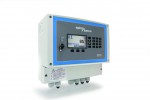No room for wastage
Published: 07 August, 2014
With energy conservation an increasingly hot topic within the process heating industry, stakeholders are now looking towards innovative methods to reduce energy consumption. Rob Brown, technical manager for Industrial Boiler Plants at Bosch Commercial and Industrial Heating, explains how a combination of technologies can be used to accompany a steam boiler to maximise energy efficiency.
Increasingly, industrial energy users are looking to maximise energy efficiency and minimise production costs and overheads. Add to that the increasing requirement for businesses to meet strict energy targets and there is a real case for reviewing energy use in order to determine where improvements can be made.
On an industrial and commercial scale, there is arguably no better place to start improving efficiencies and running costs than by taking a fresh look at the technologies available in the marketplace and how these can be utilised to maximise energy efficiency.
While alot can be done by installing modern heating and hot water technologies to reduce energy usage and lower costs, a case can be made for the combination of certain technologies to enhance energy efficiency even further. For example, integrating a Combined Heat and Power module (CHP) with a steam boiler is an innovative way of utilising the CHP system’s waste exhaust gas to create a unique arrangement which helps to increase steam generation efficiency levels.
The combination of steam and CHP
Steam is one of the most widely used commodities for transferring heat energy. Its use is popular throughout the industry for a broad range of tasks from mechanical power production, space heating and other process applications. One of the most common methods of steam generation is the use of a steam boiler, which operates using three pass technology.
The steam generated should be available at the client’s point of use in the correct quantity, at the correct pressure, clean, dry and free from air and other incondensable gases. In an industrial steam heating system, the purpose of the generation and distribution of steam is to provide heat at the process heat transfer surface - this could be using a heat exchanger.
To enhance boiler efficiency, additional heat can be transferred into the steam boiler via the waste exhaust gas from a CHP unit. A CHP module offers a more efficient way to generate heat and electrical power simultaneously, compared to conventional methods. A typical CHP module consists of a gas engine, a generator and a heat exchanger system. The gas engine drives the generator to produce three-phase electrical power, which feeds in to the main low voltage distribution system where it can be used locally.
During this process, the heat within the exhaust gases is produced as a by-product of the usable power and heat generated which, in a conventional power station, would often be wasted. However, this exhaust heat generated by a typical CHP module can be re-directed and may be used in process heating or hot water applications. Through the use of a waste gas inlet valve, this surplus heat can be transferred to a specific point of use.
By implementing an innovative fourth smoke tube pass between the CHP unit and the steam boiler, the surplus heat generated can be driven back into the steam boiler, thus maximising the energy efficiency of steam production.
System design
The production of steam was once used for space heating, yet is now generally more popular for process use. Not only is steam an excellent carrier of heat, it is also sterile, and thus commonly used in the food, pharmaceutical and health industries. It is also widely used in hospitals for sterilisation purposes.
This has meant that companies operating in this sector have generally had to address the source of electrical power and heat generation in isolation. As users of the technology will know, the installation of a steam boiler is very complex, with each steam boiler installation requiring a bespoke design. Incorporating an innovative fourth pass technology into any system design between a CHP unit and a steam boiler, can lead to considerable increases in energy efficiency in comparison to the conventional, separate electrical power and heat generation. This will also ensure reduction in CO2 and NOx emissions, providing further environmental benefits and compliance with the CRC Energy Efficiency scheme.
For further information please visit: www.bosch-industrial.co.uk





 With the launch of the its B850 Flow Computer, SPIRAX SARCO says steam system operators can now accurately measure true boiler efficiency without the need for Building Management or Supervisory Control and Data Acquisition (SCADA) systems that can be costly and time consuming to implement.
With the launch of the its B850 Flow Computer, SPIRAX SARCO says steam system operators can now accurately measure true boiler efficiency without the need for Building Management or Supervisory Control and Data Acquisition (SCADA) systems that can be costly and time consuming to implement.
